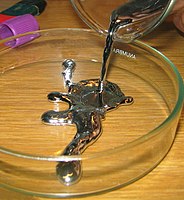
Photo from wikipedia
Abstract In a recent work we have reported the formation and the crystal structure of the new family of compounds R3Pd5 (R = Sc, Y, Gd–Lu; Pu3Pd5-type, oS32, spacegroup 63, Cmcm). DFT… Click to show full abstract
Abstract In a recent work we have reported the formation and the crystal structure of the new family of compounds R3Pd5 (R = Sc, Y, Gd–Lu; Pu3Pd5-type, oS32, spacegroup 63, Cmcm). DFT calculations for Gd3Pd5 and heat capacity and magnetic measurements for Tb3Pd5, Dy3Pd5, Ho3Pd5 and Er3Pd5 were able to discriminate at least two distinct antiferromagnetic transitions at low temperatures; at the same time these data suggested these separate magnetic orderings to be likely associated to the two structurally different rare earth sublattices (4c and 8e, respectively). The magnetic structures of the R3Pd5 compounds, with R = Tb, Dy, Ho, Er, have been now investigated in this work. High-resolution and high-intensity neutron powder diffraction data were recorded for the four compounds of the series. The results reveal that the magnetic structures adopted are significantly diverse and their temperature dependence more complex than originally deduced from magnetic and heat capacity measurements. Tb3Pd5 is in fact the only of the four compounds where the rare earth sublattices order independently with two different magnetic propagation vectors on the two sites (k1 = [1 0 ½] for Tb2 and k2 = [kx 0 0] or k3 = [1 0 0] for Tb1). In Dy3Pd5 both sublattices follow the propagation vector k = [kx 0 0], with the second transition corresponding to a spin reorientation. In Ho3Pd5 ordering of both sublattices follow the k = [1 0 0] propagation vector; the second transition seen in the magnetic and heat capacity data corresponds to an accelerated increase in the magnetic moment of the Ho2 sublattice. The case of Er3Pd5 is special as it is the sole case where one of the rare earth sublattices does not order down to T = 1.5 K; here the second transition determined from the magnetic data corresponds to a change of the magnetic propagation vector from k1 = [kx 0 kz] to k2 = [1 0 0], both only acting on the Er2 sublattice. Irrespectively of the very similar structures not even two of the four studied R3Pd5 compounds show identical magnetic structures on either of the two sublattices. These strong variations have to be connected to changes in the RKKY interactions induced by the progressive filling of the f-orbitals of the heavy rare earth ions and the concomitant changes of the crystal electric fields.
Journal Title: Journal of Alloys and Compounds
Year Published: 2020
Link to full text (if available)
Share on Social Media: Sign Up to like & get
recommendations!